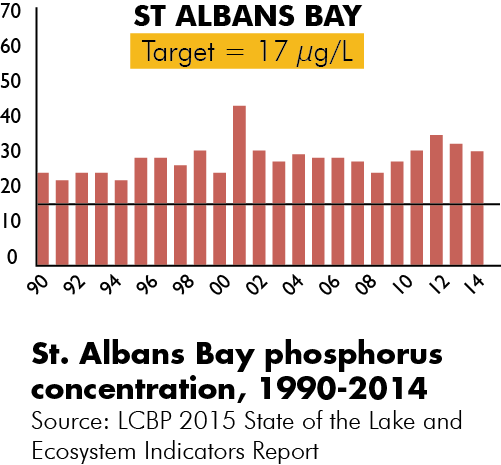News Release: LCBP Seeks Innovative Phosphorus Reduction Projects from Agricultural Sources in St. Albans, Vermont
The Lake Champlain Basin Program (LCBP) is seeking innovative proposals to reduce phosphorus pollution from agricultural sources in the St. Albans Bay watershed. St. Albans Bay remains one of the most impaired regions of Lake Champlain though it contains just one-tenth of one percent of Lake Champlain’s water volume. Local residents and businesses along the Bay continue to be frustrated that water quality has not improved after decades of effort from federal, state, and municipal sectors and private sector farmers. Up to $350,000 is available to support one or more proposals through an LCBP Request for Proposal for alternative or innovative projects to address phosphorus reduction priorities in the St. Albans Bay watershed.
“Alternative strategies for reducing phosphorus load from these impaired watersheds is required to meet reduction goals set by Lake Champlain management agencies for the St. Albans Bay watershed,” said Dr. Eric Howe, Director of the Lake Champlain Basin Program. While St. Albans is a relatively small watershed, phosphorus levels here have consistently remained above acceptable target concentrations. “As noted in the LCBP’s 2015 State of the Lake Report, the average mean August surface water temperature in St. Albans Bay is 5.2 degrees Fahrenheit warmer than it was in 1964. Warming waters, especially when coupled with high phosphorus concentrations in the water, continue to drive the formation of algae blooms in the Bay during the summer months,” stated Howe.
Assessments of the Jewett Brook and the greater St. Albans Bay watershed have shown that historical agricultural land use has created legacy phosphorus loading challenges, both in the lake sediments and in agricultural soils in the watershed that drains to the Bay. Additionally, if significant phosphorus loading reductions can be achieved from the watershed, then it is feasible that in-lake treatment options may further reduce loading into the watershed from these legacy sources.
Howe continued, “The Lake Champlain Steering Committee, the governing board of the LCBP, is pleased to designate $350,000 toward innovative solutions that will complement the more traditional agricultural conservation practices implemented by farmers, often with technical or financial assistance from the Vermont Agency of Agriculture, Food and Markets, the USDA Natural Resources Conservation Service, and other agricultural partners working to improve water quality in the Bay.” The funds will help to achieve the goals of the Lake Champlain long-term management plan Opportunities for Action: An Evolving Plan for the Future of the Lake Champlain Basin. “Each incremental step we can muster is important, and new innovative solutions can move us that much closer to our goals for improving Lake Champlain,” said Howe.
The Request for Proposals is supported with funds awarded to the New England Interstate Water Pollution Control Commission by the US Environmental Protection Agency and Great Lakes Fishery Commission in support of the Lake Champlain Basin Program. To obtain a copy of the Request for Proposals, visit www.lcbp.org/grants or contact the Lake Champlain Basin Program office at (802) 372-3213 or (800) 468-5227. Proposals are due in the LCBP office by electronic submission on January 5th, 2017 at 4:30 p.m.
